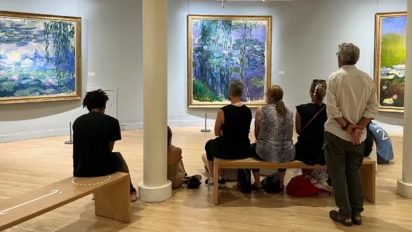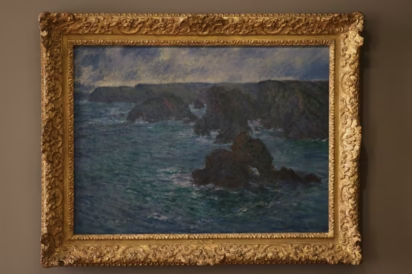The best museums in Paris to visit to see paintings by impressionist artist Claude Monet are the Orangerie, the Marmottan Museum, and the Musée d’Orsay.

The Musée Marmotton Monet in Paris owns the world’s largest collection of paintings by Claude Monet while the Orsay Museum is home to the world’s biggest collection of impressionist artworks. The Musée de l’Orangerie was specifically designed to display large paintings of water lilies that Monet painted at Giverny where Monet’s garden is a popular day-trip destination but without any of his works.
The odd Monet painting is also displayed in other Parisian museums including the Louvre (3), Rodin, Petit Palais, and Carnavalet. For most museums in Paris book time-slot entry tickets or tours well in advance, if possible and available.
Which Museums to Visit to See Monet Paintings in Paris

The three museums with the largest Claude Oscar Monet (1840-1926) collections are quite different and all three are absolutely worth visiting not only for lovers of Monet’s art. All three museums have large Impressionist collections but the Marmottan is the best for Monets.
From a practical visitor perspective keep the following in mind:
- The Marmottan Museum is slightly out of the center of Paris but not much — it is only a few minutes on the metro. The Paris Museum Pass is not accepted, so see it on a “free” day. The Musée Marmotton-Monet is closed on Monday but open late on Thursday evenings. Make time-slot reservations well in advance, as the museum is physically smaller with less space for large crowds.
- The Musée d’Orsay is massive but will usually have fewer Monet paintings on display. The museum is very popular and although Paris Museum Pass holders do not need time-slot reservations, always make them if possible. The Orsay Museum is closed on Monday but open late on Thursday. Visit first thing in the morning is sensible — at the end of a full day, visiting the smaller Marmottan or Orangerie is far less strenuous.
- The Musée de l’Orangerie is mostly visited by foreign tourists to see Monet’s large water lily paintings but locals flock to frequent blockbuster temporary exhibitions meaning time-slot reservation tickets are mostly required. In contrast to the other two museums, the Orangerie Museum is closed on Tuesday and open late on Friday evenings.
The Paris Museum Pass is accepted at the Orangerie and Orsay but free reservations may be required. Admission is free for under 18-year-olds (26 years for EU residents). Passes are not valid at the Marmottan and entry fees are charged for anyone over 7!
See Claude Monet and Berthe Morisot’s Art in the Musée Marmottan Monet in Paris

The Marmottan-Monet Museum is famous for owning the largest art collection of Claude Monet paintings in the world including Impression, Sunrise (Impression, soleil levant, 1873) — the painting that “named” the Impressionist movement.
The original collection encompassed the Empire and Restoration periods admired by art historian Jules Marmottan (1829-1883) and his art collector son Paul Marmottan(1856-1932). Many of these works are still displayed in the former 19th-century hunting lodge building.
However, the Musée Marmottan increasingly focused on Impressionism. Monet was added to the museum name after inheriting the world’s biggest Monet collection from the painter’s son Michel Monet (1966). The Musée Marmottan-Monet also owns the largest collection of works by Berthe Morisot — the first female Impressionist.
Visitors with limited time could rush through the temporary exhibitions and the older works on the ground and upper floors of the original museum building. Don’t miss Berthe Morisot’s works on the upper floor.
Head down to the modern exhibition hall in the basement to see Monet’s works and those of other Impressionist painters, such as Auguste Renoir (Portrait of Claude Monet), Manet, Pissaro, Sisley, Gauguin, and Morisot.
Monet’s works here include examples of his studies of Rouen Cathedral (Cathédrale de Rouen), the Houses of Parliament in London, the Tuileries, Gare Saint-Lazare, and D’Argenteuil.
Many of Monet’s paintings of waterlilies and his beloved garden in Giverny are in a hall with curvy walls inspired by the Orangerie, where the even larger water lilies series are on display.
→ See Visit and Buy Tickets for the Musée Marmottan Monet Museum in Paris for more details, opening hours, and tickets.
See Monet’s Water Lilies in the Orangerie in Paris

The Musée de l’Orangerie in Paris is world-famous for Monet’s eight enormous water lilies paintings (Les Nymphéas). Some were specifically painted between 1916 and 1926 for the well-lit oval exhibition halls and are the main reason to visit the popular Orangerie Museum.
Monet specified the design for the exhibition halls: two large ovals interlinked like the symbol for infinity (∞), beautifully lit, with four paintings in each room. The eight monumental canvases are all 2 meters (6.66ft) high and have a total combined length of 91 meters (299 ft).
In the basement are temporary exhibitions and art from the late 19th century and early 20th century associated with the art scene in Paris. Works on display include art by such famous artists as Renoir, Cezanne, Matisse, Derain, Utrillo, Picasso, and Rousseau.
Although the oval-shaped rooms are big, the rest of the Orangerie is relatively small with only around a dozen exhibition rooms. As the temporary exhibitions change frequently, the Musée de l’Orangerie is very busy year-round with local and foreign visitors making time-slot reservations usually essential.
→ See Visit the Orangerie Museum in Paris to See Claude Monet’s Huge Water Lilies for more details on opening hours and ticket options for this lovely small museum in the Tuileries Gardens.
See Impressionist Art in the Musée d’Orsay

The best place in the world to see Impressionist paintings is the Musée d’Orsay, home to the world’s largest and most comprehensive Impressionist art collection. The vast displays of equally popular post-impressionist art include paintings, sculptures, decorative art, photography, and drawings.
Many of Claude Monet’s paintings are displayed in the Orsay but the specific works rotate frequently. In contrast to the Marmottan and the Orangerie, Monet’s paintings here have to compete with excellent works by other impressionist painters including Vincent van Gogh, Renoir, Cézanne, Paul Gauguin, Manet, Camille Pissarro, Seurat, Pompon, and Degas.

The impressionist art is displayed on the top floor of the Orsay. Head here first thing in the morning by using either elevators or the escalators at the back of the ground level — visit the lower floors on the way out. The Impressionist painting collection is the most popular part of the museum and it gets uncomfortably crowded even on a relatively quiet day.
The Musée d’Orsay is huge but visiting it is a less daunting task than trying to cover the entire Louvre in a day. Many find the 19th and early 20th-century art easier to enjoy too.
→ See Tips on Buying Tickets and Visiting the Musée d’Orsay in Paris for more information on opening hours and tickets. Buy time-slot reservation tickets and visit first thing in the morning — this museum is very popular, especially the Impressionist gallery on the top floor.
Other Museums with Monet Paintings in Paris
The Marmottan, Orsay, and Orangery museums are by far the best places in Paris (and actually the whole world) to see art by Claude Monet. Of the nearly 2000 oil paintings Monet completed (a comprehensive list at Wikipedia), around 160 paintings and a further 30 Nympheas are in public collections in Paris.
Monet paintings displayed in other museums in Paris are rarely his best works. Except for special Impressionist or Monet exhibitions, which would require time-slot reservation tickets, seeing a Monet elsewhere in Paris is a bonus rather than a top attraction.
The Louvre Museum currently displays three Monets in room 903 (Sully Wing, Second Level). These early works are atypical — they are easily overlooked among the older Dutch and Flemish works in the same room. His beautiful Quai du Louvre, 1867, which he painted from inside the museum rather than copying old masters, is now in the Kunstmusem Den Haag.
A few Monet paintings are often on show in the Petit Palais, musée des Beaux-arts de la Ville de Paris. A top work here is Sunset on the Seine at Lavacourt, Winter Effect (Soleil couchant sur la Seine à Lavacourt, effet d’hiver), 1880. A similar version, and further Monets, are often in the Musée Carnavalet. Entry to both museums is free.
The Musée Rodin usually displays the Belle-Ile that Rodin owned but his personal Vincent van Gogh paintings are of better quality.
Visit Monet’s Garden and Home in Giverny from Paris
Monet’s home and garden in Giverny, where he lived from 1883 to 1926 and painted his famous water lilies, are a top day-trip destination from Paris. It is open daily from around early April to early November. Time-slot reservation tickets are usually essential — and sell out weeks in advance.
Guided tours from Paris to Giverny are useful for easy transportation or when entry tickets have sold out. (Combinations with Versailles and Van Gogh’s room in Auvers are good time-saving deals.) There are no paintings by Monet in his former house, studio, or garden. Although there is an Impressionist Museum in Giverny, fans of Impressionism will find more joy in the rich collections of Parisian museums.

